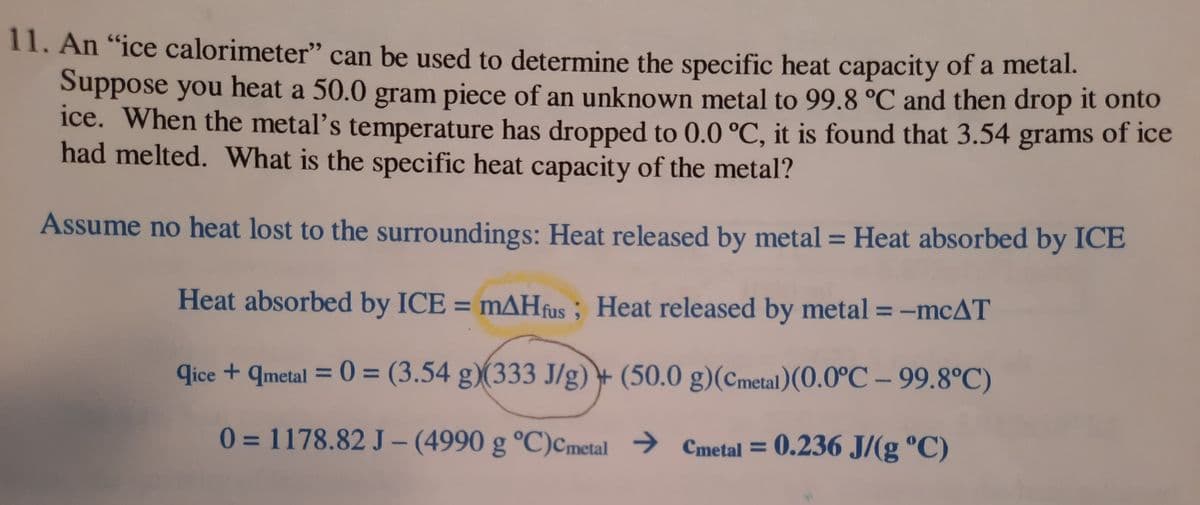11. An "ice calorimeter" can be used to determine the specific heat capacity of a metal. Suppose you heat a 50.0 gram piece of an unknown metal to 99.8 °C and then drop it onto ice. When the metal's temperature has dropped to 0.0 °C, it is found that 3.54 grams of ice had melted. What is the specific heat capacity of the metal? Assume no heat lost to the surroundings: Heat released by metal = Heat absorbed by ICE %3D Heat absorbed by ICE = mAHfus ; Heat released by metal = -mcAT qice + qmetal = 0 = (3.54 g)(333 J/g)+ (50.0 g)(Cmetal)(0.0°C – 99.8°C) %3D %3D 0 = 1178.82 J- (4990 g °C)cmetal > Cmetal = 0.236 J/(g °C) %3D
11. An "ice calorimeter" can be used to determine the specific heat capacity of a metal. Suppose you heat a 50.0 gram piece of an unknown metal to 99.8 °C and then drop it onto ice. When the metal's temperature has dropped to 0.0 °C, it is found that 3.54 grams of ice had melted. What is the specific heat capacity of the metal? Assume no heat lost to the surroundings: Heat released by metal = Heat absorbed by ICE %3D Heat absorbed by ICE = mAHfus ; Heat released by metal = -mcAT qice + qmetal = 0 = (3.54 g)(333 J/g)+ (50.0 g)(Cmetal)(0.0°C – 99.8°C) %3D %3D 0 = 1178.82 J- (4990 g °C)cmetal > Cmetal = 0.236 J/(g °C) %3D
Chemistry
10th Edition
ISBN:9781305957404
Author:Steven S. Zumdahl, Susan A. Zumdahl, Donald J. DeCoste
Publisher:Steven S. Zumdahl, Susan A. Zumdahl, Donald J. DeCoste
Chapter6: Thermochemistry
Section: Chapter Questions
Problem 64E: A 110.-g sample of copper (specific heat capacity = 0.20 J/C g) is heated to 82.4C and then placed...
Related questions
Question
100%
For the part circled in pencil, where did this number come from? For the part circled in yellow, what is this equation referred to as or representative of?

Transcribed Image Text:11. An "ice calorimeter" can be used to determine the specific heat capacity of a metal.
Suppose you heat a 50.0 gram piece of an unknown metal to 99.8 °C and then drop it onto
ice. When the metal's temperature has dropped to 0.0 °C, it is found that 3.54 grams of ice
had melted. What is the specific heat capacity of the metal?
Assume no heat lost to the surroundings: Heat released by metal = Heat absorbed by ICE
%3D
Heat absorbed by ICE = mAHfus ; Heat released by metal = -mcAT
6.
qice + qmetal = 0 = (3.54 g)(333 J/g) + (50.0 g)(Cmetal)(0.0°C – 99.8°C)
%3D
%3D
0 = 1178.82 J – (4990 g °C)Cmetal → Cmetal = 0.236 J/(g °C)
Expert Solution
This question has been solved!
Explore an expertly crafted, step-by-step solution for a thorough understanding of key concepts.
This is a popular solution!
Trending now
This is a popular solution!
Step by step
Solved in 2 steps

Knowledge Booster
Learn more about
Need a deep-dive on the concept behind this application? Look no further. Learn more about this topic, chemistry and related others by exploring similar questions and additional content below.Recommended textbooks for you

Chemistry
Chemistry
ISBN:
9781305957404
Author:
Steven S. Zumdahl, Susan A. Zumdahl, Donald J. DeCoste
Publisher:
Cengage Learning

Chemistry: An Atoms First Approach
Chemistry
ISBN:
9781305079243
Author:
Steven S. Zumdahl, Susan A. Zumdahl
Publisher:
Cengage Learning


Chemistry
Chemistry
ISBN:
9781305957404
Author:
Steven S. Zumdahl, Susan A. Zumdahl, Donald J. DeCoste
Publisher:
Cengage Learning

Chemistry: An Atoms First Approach
Chemistry
ISBN:
9781305079243
Author:
Steven S. Zumdahl, Susan A. Zumdahl
Publisher:
Cengage Learning


Chemistry by OpenStax (2015-05-04)
Chemistry
ISBN:
9781938168390
Author:
Klaus Theopold, Richard H Langley, Paul Flowers, William R. Robinson, Mark Blaser
Publisher:
OpenStax

Chemistry: The Molecular Science
Chemistry
ISBN:
9781285199047
Author:
John W. Moore, Conrad L. Stanitski
Publisher:
Cengage Learning

General Chemistry - Standalone book (MindTap Cour…
Chemistry
ISBN:
9781305580343
Author:
Steven D. Gammon, Ebbing, Darrell Ebbing, Steven D., Darrell; Gammon, Darrell Ebbing; Steven D. Gammon, Darrell D.; Gammon, Ebbing; Steven D. Gammon; Darrell
Publisher:
Cengage Learning